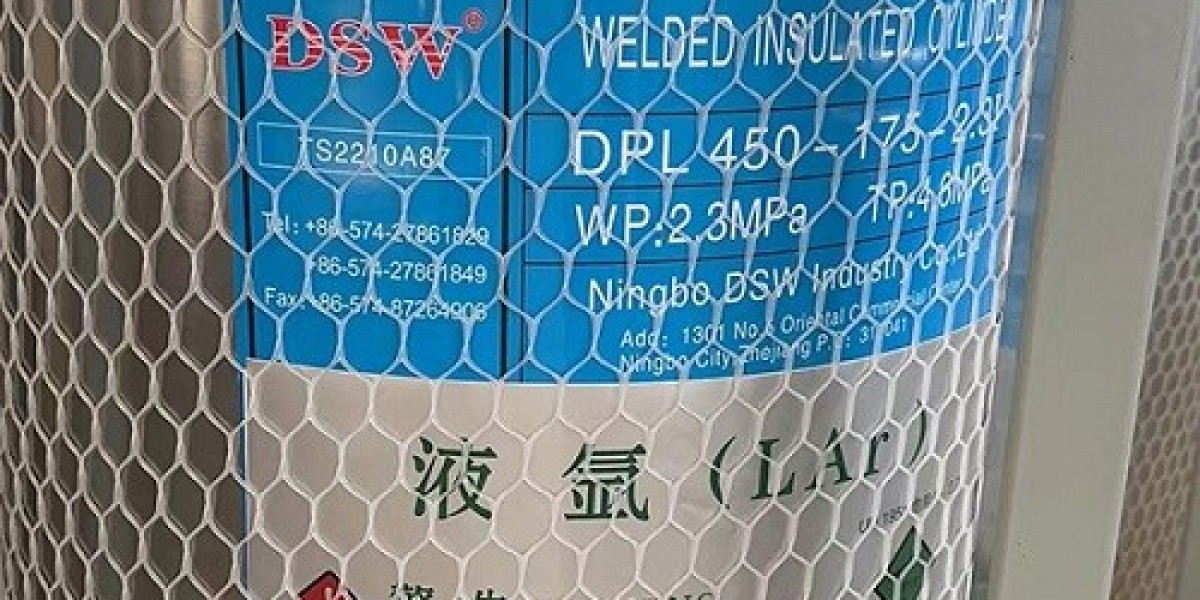Liquid nitrogen dewar also known as a cryogenic dewar or LN2 dewar, is a specialized container designed for the storage and transportation of liquid nitrogen (LN2) at extremely low temperatures. Liquid nitrogen is a cryogenic liquid with a boiling point of around -196 degrees Celsius (-321 degrees Fahrenheit) at atmospheric pressure. Due to its extremely cold temperature, it requires specialized storage solutions to prevent rapid evaporation and maintain its cryogenic properties.
Here are some key points about liquid nitrogen dewars:
Design and Construction: Liquid nitrogen dewars are typically constructed from materials with low thermal conductivity, such as stainless steel or glass-reinforced plastic, to minimize heat transfer from the environment. They consist of an inner vessel to hold the liquid nitrogen, an insulating vacuum layer to reduce heat transfer, and an outer protective casing.
Double-Walled Insulation: The most common design for liquid nitrogen dewars involves a double-walled vacuum insulation. This vacuum layer between the inner and outer walls significantly reduces heat transfer through conduction and convection, helping to keep the liquid nitrogen cold and reducing the rate of evaporation.
Capacity: Liquid nitrogen dewars come in various sizes, ranging from small containers with capacities of a few liters to large tanks that can hold thousands of liters. The choice of dewar size depends on the intended use, storage duration, and amount of liquid nitrogen needed.
Pressure Relief: As liquid nitrogen evaporates, it produces nitrogen gas, which can lead to an increase in pressure inside the dewar. To prevent excessive pressure buildup, liquid nitrogen dewars are equipped with pressure relief valves to maintain safe operating conditions.
Handling and Safety: Proper handling of liquid nitrogen and its dewars is crucial due to the extremely low temperatures involved. Protective gear, such as gloves and goggles, should be worn when handling liquid nitrogen, as contact with skin can cause severe frostbite. Additionally, adequate ventilation is important to prevent nitrogen gas buildup in enclosed spaces.
Applications: Liquid nitrogen dewars are widely used in various fields, including scientific research, medical applications, and industrial processes. They are used for freezing and preserving biological samples, cooling sensitive equipment, and conducting experiments in low-temperature environments.
Filling and Refilling: Liquid nitrogen dewars need to be periodically refilled as the stored liquid nitrogen evaporates over time. This can be done by transferring liquid nitrogen from a larger storage tank using proper safety procedures.
Transportation: Some liquid nitrogen dewars are designed for safe transportation of the cryogenic liquid. These transport dewars are equipped with features to minimize liquid nitrogen evaporation during transit.
Cryopreservation: In medical and biological applications, liquid nitrogen dewars are used for cryopreserving cells, tissues, and even human reproductive material like sperm and eggs. The extremely low temperatures of liquid nitrogen help preserve biological samples for extended periods.
It's important to note that working with liquid nitrogen and its dewars requires proper training and adherence to safety guidelines due to the potential hazards associated with cryogenic temperatures and pressure. Always follow recommended safety practices to ensure the safe handling and use of liquid nitrogen and its containers.
Cryogenic nitrogen dewars commonly referred to as LN2 dewars, are specialized containers designed for the storage, transportation, and handling of cryogenic nitrogen, specifically liquid nitrogen (LN2). Cryogenic nitrogen dewars share many similarities with general liquid nitrogen dewars, but they are designed to accommodate the unique properties and requirements of cryogenic nitrogen.
Here are some important aspects to consider when writing an article about cryogenic nitrogen dewars:
Extreme Cold Storage: Cryogenic nitrogen dewars are built to handle the extremely low temperatures of liquid nitrogen, which boils at around -196 degrees Celsius (-321 degrees Fahrenheit). The dewars are constructed using materials with low thermal conductivity to minimize heat transfer and maintain the cryogenic state of nitrogen.
Construction and Insulation: Similar to other dewars, cryogenic nitrogen dewars have double-walled insulation with a vacuum layer in between. This design significantly reduces heat transfer, thereby prolonging the retention of cryogenic temperatures and minimizing LN2 evaporation.
Pressure Control: Cryogenic nitrogen dewars are equipped with pressure relief systems to manage the buildup of nitrogen gas as the liquid nitrogen evaporates. This ensures that the internal pressure remains within safe limits.
Variety of Sizes: Cryogenic nitrogen dewars come in various sizes, catering to different storage needs. They can range from small portable units used in laboratories to larger tanks used in industrial and research settings.
Applications:Discuss the diverse applications of cryogenic nitrogen dewars, including cryopreservation of biological samples, cooling and freezing in scientific experiments, and industrial processes that require extremely low temperatures.
Biomedical and Medical Applications: Highlight the use of cryogenic nitrogen dewars in medical and biomedical fields for cryopreserving biological materials, such as stem cells, tissues, and organs, for potential use in transplantation and regenerative medicine.
Cryogenic Research: Detail how cryogenic nitrogen dewars are used in various research fields, such as physics, chemistry, and materials science, to create controlled low-temperature environments for experimentation.
Transport and Safety: Discuss the challenges and safety considerations associated with transporting cryogenic nitrogen dewars. Proper handling, training, and protective equipment are essential due to the extreme cold and potential hazards.
Maintenance and Refilling: Describe the maintenance requirements of cryogenic nitrogen dewars, including regular inspection, leak testing, and refilling procedures. Explain how liquid nitrogen is replenished in these dewars using established safety protocols.
Future Trends: Explore any emerging technologies or advancements in cryogenic nitrogen dewar design, materials, and safety features that are shaping the field.
Environmental Impact: Consider the environmental aspects associated with LN2 dewars, such as nitrogen gas release and energy consumption due to evaporation. Discuss any efforts to reduce these impacts.
Regulations and Standards: Highlight relevant regulations and standards governing the use, handling, and transportation of cryogenic nitrogen and its dewars.
Cryogenic nitrogen tanks would cover various aspects related to their design, applications, safety considerations, and importance in various industries.
Introduction to Cryogenic Nitrogen Tanks:
Briefly explain what cryogenic nitrogen tanks are and their significance in storing and handling extremely cold substances.Highlight their role in maintaining the cryogenic state of nitrogen which is essential for various applications.
Design and Construction:
Describe the construction of cryogenic nitrogen tanks, including double-walled insulation with vacuum layers to minimize heat transfer.Explain how the inner vessel holds the liquid nitrogen, while the outer shell provides protection.
Thermal Insulation and Dewar Technology:
Detail the importance of thermal insulation in cryogenic nitrogen tanks to prevent heat transfer and maintain low temperatures.Discuss the concept of Dewar technology and its role in minimizing evaporation rates.
Applications of Cryogenic Nitrogen Tanks:
Biomedical: Cryopreservation of biological materials, tissue samples, and even human reproductive cells.
Scientific Research: Creating controlled low-temperature environments for experiments in fields like physics, chemistry, and materials science.
Medical and Pharmaceuticals: Storage of vaccines, blood products, and temperature-sensitive medications.
Food Industry: Freezing and preserving food products, especially those requiring low-temperature storage.
Energy and Electronics: Cooling superconducting materials, semiconductors, and industrial equipment.
Industrial Processes: Cryogenic nitrogen for inerting, purging, and cooling in various manufacturing processes.
Safety Considerations:
Emphasize the importance of safety when dealing with cryogenic nitrogen tanks due to the extremely low temperatures and potential hazards.
Address the risk of frostbite, as well as oxygen displacement when working with cryogenic gases.
Handling and Training:
Discuss the need for proper training and protective gear when handling cryogenic nitrogen tanks.Highlight the importance of well-ventilated areas and controlled environments.
Transportation and Storage:
Explain the challenges and safety measures associated with transporting cryogenic nitrogen tanks due to their contents and low temperatures.Describe the guidelines for proper storage of both filled and empty tanks.
Maintenance and Refilling:
Detail the maintenance practices necessary to ensure cryogenic nitrogen tanks function properly and safely.Explain the process of refilling tanks as liquid nitrogen evaporates over time.
Environmental Impact and Sustainability:
Discuss any efforts within the industry to optimize energy consumption during cryogenic nitrogen production and reduce waste.
Regulations and Standards:
Mention relevant regulations and standards that govern the use, storage, and transportation of cryogenic nitrogen and its tanks.
Future Trends and Innovations:
Explore any advancements in cryogenic tank design materials, and technologies that are enhancing safety, efficiency, and performance. Summarize the significance of cryogenic nitrogen tanks across industries, emphasizing their role in enabling various scientific, medical, and industrial advancements.ensure you gather information from reputable sources, cite relevant studies or industry standards, and provide practical examples to illustrate the applications and importance of cryogenic nitrogen tanks.



